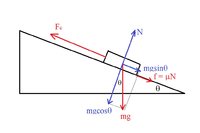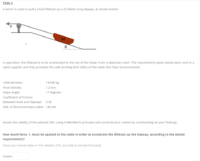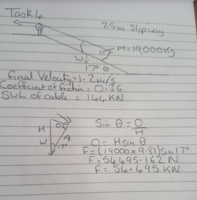You are using an out of date browser. It may not display this or other websites correctly.
You should upgrade or use an alternative browser.
You should upgrade or use an alternative browser.
conservation of energy problem
- Thread starter vinn1ev
- Start date
D
Deleted member 4993
Guest
You need to draw the Free-Body-Diagram of the mass - which will be subjected toive got the below question. ive calculated the force required to pull the boat up the incline but how do i factor in the coefficient of friction (my working out is below too)
View attachment 27930
View attachment 27931
tensile force from the cable (T),
gravity force (mg),
Normal force (N),
frictional force (µN) and
inertial force (ma).
I would select x-axis parallel to the slip-way (positive going up). Now apply D 'Alembert's Principle and solve.
skeeter
Elite Member
- Joined
- Dec 15, 2005
- Messages
- 3,215
sorry for being dumb but i dont get any of that lol
In post #2, Khan mentioned a free-body diagram of the forces acting on the boat. (attached) The net force is up and parallel to the incline.
I posted the relevant equation to find the acceleration necessary to move 25 m up the incline with an initial speed of 0 m/s and final speed of 1.2 m/s.
The force of friction is [MATH]f = \mu \cdot N[/MATH], where [MATH]N = mg\cos{\theta}[/MATH]
With that acceleration, you can use the net force equation to determine the force of the cable necessary to achieve that acceleration.



